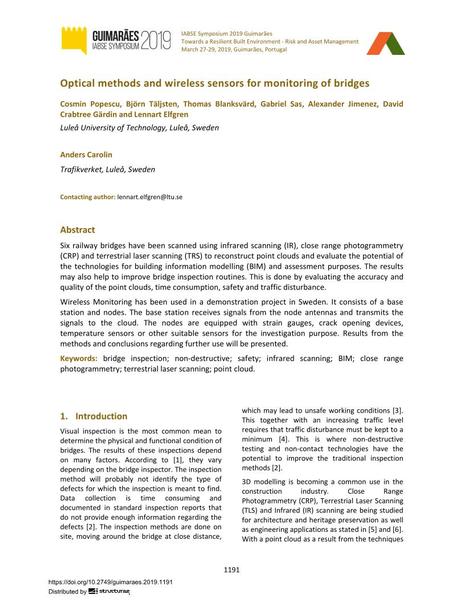Optical methods and wireless sensors for monitoring of bridges

|
|
|||||||||||
Bibliographic Details
| Author(s): |
Cosmin Popescu
Björn Täljsten (Luleå University of Technology, Luleå, Sweden) Thomas Blanksvärd (Luleå University of Technology, Luleå, Sweden) Gabriel Sas (Luleå University of Technology, Luleå, Sweden) Alexander Jimenez (Luleå University of Technology, Luleå, Sweden) David Crabtree Gärdin (Luleå University of Technology, Luleå, Sweden) Lennart Elfgren Anders Carolin (Trafikverket, Luleå, Sweden) |
||||
|---|---|---|---|---|---|
| Medium: | conference paper | ||||
| Language(s): | English | ||||
| Conference: | IABSE Symposium: Towards a Resilient Built Environment Risk and Asset Management, Guimarães, Portugal, 27-29 March 2019 | ||||
| Published in: | IABSE Symposium Guimarães 2019 | ||||
|
|||||
| Page(s): | 1191-1198 | ||||
| Total no. of pages: | 8 | ||||
| DOI: | 10.2749/guimaraes.2019.1191 | ||||
| Abstract: |
Six railway bridges have been scanned using infrared scanning (IR), close range photogrammetry (CRP) and terrestrial laser scanning (TRS) to reconstruct point clouds and evaluate the potential of the technologies for building information modelling (BIM) and assessment purposes. The results may also help to improve bridge inspection routines. This is done by evaluating the accuracy and quality of the point clouds, time consumption, safety and traffic disturbance. Wireless Monitoring has been used in a demonstration project in Sweden. It consists of a base station and nodes. The base station receives signals from the node antennas and transmits the signals to the cloud. The nodes are equipped with strain gauges, crack opening devices, temperature sensors or other suitable sensors for the investigation purpose. Results from the methods and conclusions regarding further use will be presented. |
||||
| Keywords: |
bridge Inspection non-destructive safety close range photogrammetry BIM terrestrial laser scanning point cloud infrared scanning
|
||||
